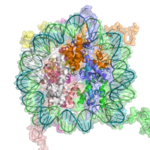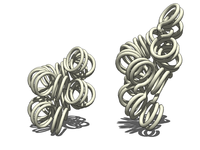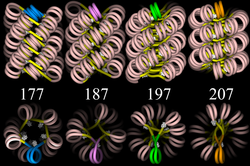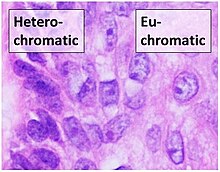Chromatin
Chromatin is a complex of DNA and protein found in eukaryotic cells.[1] The primary function is to package long DNA molecules into more compact, denser structures. This prevents the strands from becoming tangled and also plays important roles in reinforcing the DNA during cell division, preventing DNA damage, and regulating gene expression and DNA replication. During mitosis and meiosis, chromatin facilitates proper segregation of the chromosomes in anaphase; the characteristic shapes of chromosomes visible during this stage are the result of DNA being coiled into highly condensed chromatin.
The primary protein components of chromatin are
- DNA wraps around histone proteins, forming beads on a string structure (euchromatin).
- Multiple histones wrap into a 30-nanometer fiber consisting of nucleosome arrays in their most compact form (heterochromatin).[a]
- Higher-level DNA supercoiling of the 30 nm fiber produces the metaphasechromosome (during mitosis and meiosis).
Many organisms, however, do not follow this organization scheme. For example,
The overall structure of the chromatin network further depends on the stage of the
Dynamic chromatin structure and hierarchy


Chromatin undergoes various structural changes during a
Polycomb-group proteins play a role in regulating genes through modulation of chromatin structure.[7]
For additional information, see
Structure of DNA

In nature, DNA can form three structures,
At the junction of B- and Z-DNA, one pair of bases is flipped out from normal bonding. These play a dual role of a site of recognition by many proteins and as a sink for torsional stress from RNA polymerase or nucleosome binding.DNA bases are stored as a code structure with four chemical bases such as “Adenine (A), Guanine (G), Cytosine (C), and Thymine (T)”. The order and sequences of these chemical structures of DNA are reflected as information available for the creation and control of human organisms. “A with T and C with G” pairing up to build the DNA base pair. Sugar and phosphate molecules are also paired with these bases, making DNA nucleotides arrange 2 long spiral strands unitedly called “double helix”.[8] In eukaryotes, DNA consists of a cell nucleus and the DNA is providing strength and direction to the mechanism of heredity. Moreover, between the nitrogenous bonds of the 2 DNA, homogenous bonds are forming.
Nucleosomes and beads-on-a-string

The basic repeat element of chromatin is the nucleosome, interconnected by sections of linker DNA, a far shorter arrangement than pure DNA in solution.
In addition to core histones, a linker
The nucleosomes bind DNA non-specifically, as required by their function in general DNA packaging. There are, however, large DNA sequence preferences that govern nucleosome positioning. This is due primarily to the varying physical properties of different DNA sequences: For instance, adenine (A), and thymine (T) is more favorably compressed into the inner minor grooves. This means nucleosomes can bind preferentially at one position approximately every 10 base pairs (the helical repeat of DNA)- where the DNA is rotated to maximise the number of A and T bases that will lie in the inner minor groove. (See nucleic acid structure.)
30-nm chromatin fiber in mitosis

Left: 1 start helix "solenoid" structure.
Right: 2 start loose helix structure.
Note: the histones are omitted in this diagram - only the DNA is shown.
With addition of H1, during
This level of chromatin structure is thought to be the form of heterochromatin, which contains mostly transcriptionally silent genes. Electron microscopy studies have demonstrated that the 30 nm fiber is highly dynamic such that it unfolds into a 10 nm fiber beads-on-a-string structure when transversed by an RNA polymerase engaged in transcription.

Linker DNA in yellow and nucleosomal DNA in pink.
The existing models commonly accept that the nucleosomes lie perpendicular to the axis of the fibre, with linker histones arranged internally. A stable 30 nm fibre relies on the regular positioning of nucleosomes along DNA. Linker DNA is relatively resistant to bending and rotation. This makes the length of linker DNA critical to the stability of the fibre, requiring nucleosomes to be separated by lengths that permit rotation and folding into the required orientation without excessive stress to the DNA. In this view, different lengths of the linker DNA should produce different folding topologies of the chromatin fiber. Recent theoretical work, based on electron-microscopy images[11] of reconstituted fibers supports this view.[12]
DNA loops
The beads-on-a-string chromatin structure has a tendency to form loops. These loops allow interactions between different regions of DNA by bringing them closer to each other, which increases the efficiency of gene interactions. This process is dynamic, with loops forming and disappearing. The loops are regulated by two main elements:[14]
- Cohesins, protein complexes that generate loops by extrusion of the DNA fiber through the ring-like structure of the complex itself.[13]
- CTCF, a transcription factor that limits the frontier of the DNA loop. To stop the growth of a loop, two CTCF molecules must be positioned in opposite directions to block the movement of the cohesin ring (see video).[13]
There are many other elements involved. For example, Jpx regulates the binding sites of CTCF molecules along the DNA fiber.[15]
Spatial organization of chromatin in the cell nucleus
The spatial arrangement of the chromatin within the nucleus is not random - specific regions of the chromatin can be found in certain territories. Territories are, for example, the lamina-associated domains (LADs), and the topologically associating domains (TADs), which are bound together by protein complexes.[16] Currently, polymer models such as the Strings & Binders Switch (SBS) model[17] and the Dynamic Loop (DL) model[18] are used to describe the folding of chromatin within the nucleus. The arrangement of chromatin within the nucleus may also play a role in nuclear stress and restoring nuclear membrane deformation by mechanical stress. When chromatin is condensed, the nucleus becomes more rigid. When chromatin is decondensed, the nucleus becomes more elastic with less force exerted on the inner nuclear membrane. This observation sheds light on other possible cellular functions of chromatin organization outside of genomic regulation.[2]
Cell-cycle dependent structural organization

- Interphase: The structure of chromatin during Genes that require regular access by RNA polymeraserequire the looser structure provided by euchromatin.
- Metaphase: The epigenetic mechanism believed to be important for transmitting to daughter cells the "memory" of which genes were active prior to entry into mitosis.[21] This bookmarking mechanism is needed to help transmit this memory because transcription ceases during mitosis.
Chromatin and bursts of transcription
Chromatin and its interaction with enzymes has been researched, and a conclusion being made is that it is relevant and an important factor in gene expression. Vincent G. Allfrey, a professor at Rockefeller University, stated that RNA synthesis is related to histone acetylation.[22] The lysine amino acid attached to the end of the histones is positively charged. The acetylation of these tails would make the chromatin ends neutral, allowing for DNA access.
When the chromatin decondenses, the DNA is open to entry of molecular machinery. Fluctuations between open and closed chromatin may contribute to the discontinuity of transcription, or transcriptional bursting. Other factors are probably involved, such as the association and dissociation of transcription factor complexes with chromatin. Specifically, RNA polymerase and transcriptional proteins have been shown to congregate into droplets via phase separation, and recent studies have suggested that 10 nm chromatin demonstrates liquid-like behavior increasing the targetability of genomic DNA.[23] The interactions between linker histones and disordered tail regions act as an electrostatic glue organizing large-scale chromatin into a dynamic, liquid-like domain. Decreased chromatin compaction comes with increased chromatin mobility and easier transcriptional access to DNA.[2] The phenomenon, as opposed to simple probabilistic models of transcription, can account for the high variability in gene expression occurring between cells in isogenic populations.[24]
Alternative chromatin organizations
During metazoan
Chromatin and DNA repair
A variety of internal and external agents can cause DNA damage in cells. Many factors influence how the repair route is selected, including the cell cycle phase and chromatin segment where the break occurred. In terms of initiating 5’ end DNA repair, the p53 binding protein 1 (53BP1) and BRCA1 are important protein components that influence double-strand break repair pathway selection. The 53BP1 complex attaches to chromatin near DNA breaks and activates downstream factors such as Rap1-Interacting Factor 1 (RIF1) and shieldin, which protects DNA ends against nucleolytic destruction. DNA damage process occurs within the condition of chromatin, and the constantly changing chromatin environment has a large effect on it.[28] Accessing and repairing the damaged cell of DNA, the genome condenses into chromatin and repairing it through modifying the histone residues. Through altering the chromatin structure, histones residues are adding chemical groups namely phosphate, acetyl and one or more methyl groups and these control the expressions of gene building by proteins to acquire DNA.[29] Moreover, resynthesis of the delighted zone, DNA will be repaired by processing and restructuring the damaged bases. In order to maintain genomic integrity, “homologous recombination and classical non-homologous end joining process” has been followed by DNA to be repaired.[30]
The packaging of eukaryotic DNA into chromatin presents a barrier to all DNA-based processes that require recruitment of enzymes to their sites of action.
Chromatin relaxation occurs rapidly at the site of DNA damage.[33] This process is initiated by PARP1 protein that starts to appear at DNA damage in less than a second, with half maximum accumulation within 1.6 seconds after the damage occurs.[34] Next the chromatin remodeler Alc1 quickly attaches to the product of PARP1, and completes arrival at the DNA damage within 10 seconds of the damage.[33] About half of the maximum chromatin relaxation, presumably due to action of Alc1, occurs by 10 seconds.[33] This then allows recruitment of the DNA repair enzyme MRE11, to initiate DNA repair, within 13 seconds.[34]
γH2AX, the phosphorylated form of H2AX is also involved in the early steps leading to chromatin decondensation after DNA damage occurrence. The histone variant H2AX constitutes about 10% of the H2A histones in human chromatin.[35] γH2AX (H2AX phosphorylated on serine 139) can be detected as soon as 20 seconds after irradiation of cells (with DNA double-strand break formation), and half maximum accumulation of γH2AX occurs in one minute.[35] The extent of chromatin with phosphorylated γH2AX is about two million base pairs at the site of a DNA double-strand break.[35] γH2AX does not, itself, cause chromatin decondensation, but within 30 seconds of irradiation, RNF8 protein can be detected in association with γH2AX.[36] RNF8 mediates extensive chromatin decondensation, through its subsequent interaction with CHD4,[37] a component of the nucleosome remodeling and deacetylase complex NuRD.
After undergoing relaxation subsequent to DNA damage, followed by DNA repair, chromatin recovers to a compaction state close to its pre-damage level after about 20 min.[33]
Methods to investigate chromatin

- histone modifications, can be used to identify chromatin states throughout the genome. Different modifications have been linked to various states of chromatin.[41]
- DNase Ienzyme to map open or accessible regions in the genome.
- FAIRE-seq (Formaldehyde-Assisted Isolation of Regulatory Elements sequencing) uses the chemical properties of protein-bound DNA in a two-phase separation method to extract nucleosome depleted regions from the genome.[42]
- ATAC-seq (Assay for Transposable Accessible Chromatin sequencing) uses the Tn5 transposase to integrate (synthetic) transposons into accessible regions of the genome consequentially highlighting the localisation of nucleosomes and transcription factors across the genome.
- DNA footprinting is a method aimed at identifying protein-bound DNA. It uses labeling and fragmentation coupled to gel electrophoresis to identify areas of the genome that have been bound by proteins.[43]
- MNase-seq (Micrococcal Nuclease sequencing) uses the micrococcal nuclease enzyme to identify nucleosome positioning throughout the genome.[44][45]
- Chromosome conformation capture determines the spatial organization of chromatin in the nucleus, by inferring genomic locations that physically interact.
- MACC profiling (Micrococcal nuclease ACCessibility profiling) uses titration series of chromatin digests with micrococcal nuclease to identify chromatin accessibility as well as to map nucleosomes and non-histone DNA-binding proteins in both open and closed regions of the genome.[46]
Chromatin and knots
It has been a puzzle how decondensed interphase chromosomes remain essentially unknotted. The natural expectation is that in the presence of type II DNA topoisomerases that permit passages of double-stranded DNA regions through each other, all chromosomes should reach the state of topological equilibrium. The topological equilibrium in highly crowded interphase chromosomes forming chromosome territories would result in formation of highly knotted chromatin fibres. However, Chromosome Conformation Capture (3C) methods revealed that the decay of contacts with the genomic distance in interphase chromosomes is practically the same as in the crumpled globule state that is formed when long polymers condense without formation of any knots. To remove knots from highly crowded chromatin, one would need an active process that should not only provide the energy to move the system from the state of topological equilibrium but also guide topoisomerase-mediated passages in such a way that knots would be efficiently unknotted instead of making the knots even more complex. It has been shown that the process of chromatin-loop extrusion is ideally suited to actively unknot chromatin fibres in interphase chromosomes.[47]
Chromatin: alternative definitions
The term, introduced by Walther Flemming, has multiple meanings:
- Simple and concise definition: Chromatin is a macromolecular complex of a DNA macromolecule and protein macromolecules (and RNA). The proteins package and arrange the DNA and control its functions within the cell nucleus.
- A biochemists' operational definition: Chromatin is the DNA/protein/RNA complex extracted from eukaryotic lysed interphase nuclei. Just which of the multitudinous substances present in a nucleus will constitute a part of the extracted material partly depends on the technique each researcher uses. Furthermore, the composition and properties of chromatin vary from one cell type to another, during the development of a specific cell type, and at different stages in the cell cycle.
- The DNA + histone = chromatin definition: The DNA double helix in the cell nucleus is packaged by special proteins termed histones. The formed protein/DNA complex is called chromatin. The basic structural unit of chromatin is the nucleosome.
The first definition allows for "chromatins" to be defined in other domains of life like bacteria and archaea, using any DNA-binding proteins that condenses the molecule. These proteins are usually referred to nucleoid-associated proteins (NAPs); examples include AsnC/LrpC with HU. In addition, some archaea do produce nucleosomes from proteins homologous to eukaryotic histones.[48]
Chromatin Remodeling:
Chromatin remodeling can result from covalent modification of histones that physically remodel, move or remove nucleosomes.[49] Studies of Sanosaka et al 2022, says that Chromatin remodeler CHD7 regulate cell type-specific gene expression in human neural crest cells. [50]
Nobel Prizes
The following scientists were recognized for their contributions to chromatin research with Nobel Prizes:
| Year | Who | Award |
|---|---|---|
| 1910 | Albrecht Kossel (University of Heidelberg) | Nobel Prize in Physiology or Medicine for his discovery of the five nuclear bases: adenine, cytosine, guanine, thymine, and uracil. |
| 1933 | Thomas Hunt Morgan (California Institute of Technology) | Nobel Prize in Physiology or Medicine for his discoveries of the role played by the gene and chromosome in heredity, based on his studies of the white-eyed mutation in the fruit fly Drosophila.[51] |
| 1962 | James Watson and Maurice Wilkins (MRC Laboratory of Molecular Biology, Harvard University and London University respectively)
|
Nobel Prize in Physiology or Medicine for their discoveries of the double helix structure of DNA and its significance for information transfer in living material. |
| 1982 | Aaron Klug (MRC Laboratory of Molecular Biology) | Nobel Prize in Chemistry "for his development of crystallographic electron microscopy and his structural elucidation of biologically important nucleic acid-protein complexes" |
| 1993 | Phillip A. Sharp
|
introns , which do not express proteins.
|
| 2006 | Roger Kornberg (Stanford University)
|
Nobel Prize in Chemistry for his discovery of the mechanism by which DNA is transcribed into messenger RNA. |
See also
Notes
- nanometer fibre was not seen in recent X-ray studies of human mitotic chromosomes.[3]
References
- PMID 20404130.
- ^ a b c d Maeshima, K., Ide, S., & Babokhov, M. (2019). Dynamic chromatin organization without the 30 nm fiber. Current opinion in cell biology, 58, 95–104. https://doi.org/10.1016/j.ceb.2019.02.003
- PMID 22415369.
- ^
Dame, R.T. (May 2005). "The role of nucleoid-associated proteins in the organization and compaction of bacterial chromatin". S2CID 26965112.
- ^ Shogren-Knaak, M., Ishii, H., Sun, J. M., Pazin, M. J., Davie, J. R., & Peterson, C. L. (2006). Histone H4-K16 acetylation controls chromatin structure and protein interactions. Science, 311(5762), 844–847. https://doi.org/10.1126/science.1124000
- ^
Bernstein BE, Mikkelsen TS, Xie X, Kamal M, Huebert DJ, Cuff J, Fry B, Meissner A, Wernig M, Plath K, Jaenisch R, Wagschal A, Feil R, Schreiber SL, Lander ES (April 2006). "A bivalent chromatin structure marks key developmental genes in embryonic stem cells". S2CID 9993008.
- ISBN 978-1-904455-25-7.
- PMID 33744292.
- PMID 31652314.
- ^ Annunziato, Anthony T. "DNA Packaging: Nucleosomes and Chromatin". Scitable. Nature Education. Retrieved 2015-10-29.
- ^
Robinson DJ; Fairall L; Huynh VA; Rhodes D. (April 2006). "EM measurements define the dimensions of the "30-nm" chromatin fiber: Evidence for a compact, interdigitated structure". PMID 16617109.
- ^
Wong H, Victor JM, Mozziconacci J (September 2007). Chen P (ed.). "An All-Atom Model of the Chromatin Fiber Containing Linker Histones Reveals a Versatile Structure Tuned by the Nucleosomal Repeat Length". PMID 17849006.

- ^ PMID 29728444.
- PMID 18675948.
- PMID 34856126.
- (PDF) from the original on 2017-09-21.
- PMID 18493085.
- PMID 20811620.
- ISBN 978-1-4641-8339-3.
- PMID 26132639.
- PMID 18931662.
- PMID 14172992.
- ^ Maeshima, K., Ide, S., Hibino, K., & Sasai, M. (2016). Liquid-like behavior of chromatin. Current opinion in genetics & development, 37, 36–45. https://doi.org/10.1016/j.gde.2015.11.006
- PMID 22944281.
- PMID 23213436.
- PMID 25063301.
- PMID 28303166.
- PMID 32784607.
- PMID 33061931.
- S2CID 235672793.
- PMID 22183589
- PMID 23633913.
- ^ PMID 27733626.
- ^ PMID 18025084.
- ^ PMID 9488723.
- S2CID 14232192.
- PMID 22531782.
- PMID 17699847.
- S2CID 232277473.
- S2CID 231304041, retrieved 2022-10-24
- PMID 33692541.
- PMID 17179217.
- PMID 212715.
- PMID 22183607.
- PMID 24097267.
- PMID 27151365.
- PMID 30961051.
- S2CID 85874882.
- ^ "Chromatin remodelling - Latest research and news | Nature". www.nature.com. Retrieved 2023-01-07.
- PMID 36587182.
- ^ "Thomas Hunt Morgan and His Legacy". Nobelprize.org. 7 Sep 2012
Additional sources
- Cooper, Geoffrey M. 2000. The Cell, 2nd edition, A Molecular Approach. Chapter 4.2 Chromosomes and Chromatin.
- Corces, V. G. (1995). "Chromatin insulators. Keeping enhancers under control". Nature. 376 (6540): 462–463. S2CID 26494996.
- Cremer, T. 1985. Von der Zellenlehre zur Chromosomentheorie: Naturwissenschaftliche Erkenntnis und Theorienwechsel in der frühen Zell- und Vererbungsforschung, Veröffentlichungen aus der Forschungsstelle für Theoretische Pathologie der Heidelberger Akademie der Wissenschaften. Springer-Vlg., Berlin, Heidelberg.
- Elgin, S. C. R. (ed.). 1995. Chromatin Structure and Gene Expression, vol. 9. IRL Press, Oxford, New York, Tokyo.
- Gerasimova, T. I.; Corces, V. G. (1996). "Boundary and insulator elements in chromosomes". Curr. Opin. Genet. Dev. 6 (2): 185–192. PMID 8722175.
- Gerasimova, T. I.; Corces, V. G. (1998). "Polycomb and Trithorax group proteins mediate the function of a chromatin insulator". Cell. 92 (4): 511–521. S2CID 8192263.
- Gerasimova, T. I.; Corces, V. G. (2001). "CHROMATIN INSULATORS AND BOUNDARIES: Effects on Transcription and Nuclear Organization". Annu Rev Genet. 35: 193–208. S2CID 22738830.
- Gerasimova, T. I.; Byrd, K.; Corces, V. G. (2000). "A chromatin insulator determines the nuclear localization of DNA [In Process Citation]". Mol Cell. 6 (5): 1025–35. PMID 11106742.
- Ha, S. C.; Lowenhaupt, K.; Rich, A.; Kim, Y. G.; Kim, K. K. (2005). "Crystal structure of a junction between B-DNA and Z-DNA reveals two extruded bases". Nature. 437 (7062): 1183–6. S2CID 2539819.
- Pollard, T., and W. Earnshaw. 2002. Cell Biology. Saunders.
- Saumweber, H. 1987. Arrangement of Chromosomes in Interphase Cell Nuclei, p. 223-234. In W. Hennig (ed.), Structure and Function of Eucaryotic Chromosomes, vol. 14. Springer-Verlag, Berlin, Heidelberg.
- Sinden, R. R. (2005). "Molecular biology: DNA twists and flips". Nature. 437 (7062): 1097–8. S2CID 4409092.
- Van Holde KE. 1989. Chromatin. New York: ISBN 0-387-96694-3.
- Van Holde, K., J. Zlatanova, G. Arents, and E. Moudrianakis. 1995. Elements of chromatin structure: histones, nucleosomes, and fibres, p. 1-26. In S. C. R. Elgin (ed.), Chromatin structure and gene expression. IRL Press at Oxford University Press, Oxford.
External links
- Chromatin, Histones & Cathepsin; PMAP The Proteolysis Map-animation
- Nature journal: recent chromatin publications and news
- Protocol for in vitro Chromatin Assembly
- ENCODE threads Explorer Chromatin patterns at transcription factor binding sites. Nature (journal)
